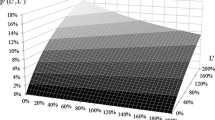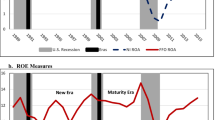Abstract
The adjusted present value requires an estimate of the cost of equity of an unlevered firm. Traditional approaches for calculating this cost assume that firms maintain a constant market-value percentage of debt when in fact firms typically use a book-value percentage of debt. In this paper, we present an approach to correctly estimate the cost of equity of an unlevered firm whenever the firm fails to maintain a constant market-value-based leverage ratio. We also demonstrate that both the Modigliani and Miller (1963) and Miles and Ezzell (1980) approaches may yield substantial valuation errors when firms determine debt levels based on book-value percentages. In contrast our method makes no errors as long as managers know the marginal tax benefit of debt.
Similar content being viewed by others
References
Arditti, F.D., and H. Levy, “The Weighted Average Cost of Capital as a Cutoff Rate: A Critical Examination of the Classical Textbook Weighted Average.” Financial Management 24–34, (Fall 1977).
Beaver, W.H., and S.G. Ryan, “Accounting Fundamentals of the Book-to-Market Ratio.” Financial Analysts Journal 50–56, (November-December 1993).
Beranek, W., “The Weighted Average Cost of Capital and Shareholder Wealth Maximization.” Journal of Financial and Quantitative Analysis 17–31, (March 1977).
Beranek, W., “Some New Capital Budgeting Theorems.” Journal of Financial and Quantitative Analysis 809–23, (December 1978).
Bernhard, R., “Some New Capital Budgeting Theorems: Comment.” Journal of Financial and Quantitative Analysis 825–29, (December 1978).
Boudreaux, K.J., and R.W. Long, “The Weighted Average Cost of Capital as a Cutoff Rate: A Further Analysis.” Financial Management 7–14, (Summer 1979).
Brealey, R., and S. Myers, Principles of Corporate Finance. 4th edition, New York: McGraw Hill, 1991.
Brick, I.E., and D.G. Weaver, “A Comparison of Capital Budgeting Techniques in Identifying Profitable Investments.” Financial Management 29–39, (Winter 1984).
Brick, J.R., and H.E. Thompson, “The Economic Life of an Investment and the Appropriate Discount Rate.” Journal of Financial and Quantitative Analysis 831–846, (December 1978).
Chambers, D.R., R.S. Harris, and J.J. Pringle, “Treatment of Financing Mix in Analyzing Investment Opportunities.” Financial Management 24–41, (Summer 1982).
Ezzell, J.R., and J.A. Miles, “Capital Project Analysis and the Debt Transaction Plan.” Journal of Financial Research 25–31, (Spring 1983).
Frecka, T.J., and C. F. Lee, “Generalized Financial Ratio Adjustment Processes and Their Implications.” Journal of Accounting Research 308–316, (Spring 1983).
Lee, C.F., and C. Wu, “Expectation Formation and Financial Ratio Adjustment Processes.” The Accounting Review 292–306, (April 1988).
Lewellen, W.G., and D.R. Emery, “Corporate Debt Management and the Value of the Firm.” Journal of Financial and Quantitative Analysis 415–25, (December 1986).
Lev, B., “Industry Averages as Targets for Financial Ratios.” Journal of Accounting Research 290–299, (Autumn 1969).
Marsh, P., “The Choice between Equity and Debt: An Empirical Study.” Journal of Finance 121–144, (March 1982).
Miles, J., and R. Ezzell, “The Weighted Average Cost of Capital, Perfect Capital Markets, and Project Life: A Clarification.” Journal of Financial and Quantitative Analysis 719–730, (September 1980).
Miller, M., “Debt and Taxes.” Journal of Finance 261–275, (May 1977).
Modigliani, F., and M. Miller, “Corporate Income Taxes and the Cost of Capital: A Correction.” American Economic Review 433–443, (June 1963).
Myers, S.C., “Interactions of Corporate Financing and Investment Decisions-Implications for Capital Budgeting.” Journal of Finance 1–25, (March 1974).
Myers, S.C., and R.S. Rubak, “Discounting Rules for Risky Assets.” Harvard Business School Working Paper, November 1988.
Robicheck, A., and S. C. Myers, “Risk-Adjusted Discount Rates.” Journal of Finance 727–730, (December 1966).
Rubak, R.S., “Calculating the Market Value of Risk-Free Cash Flows.” Journal of Financial Economics 323–39, (March 1986).
Schall, L.D., and C.W. Haley, “Problems with the Concept of the Cost of Capital.” Journal of Financial and Quantitative Analysis 847–56, (December 1978).
Schall, L.D., and C.W. Haley, Introduction to Financial Management, 3rd Edition, New York, McGraw-Hill, 1983.
Smith, C. Jr., and J. B. Warner, “On Financial Contracting: An Analysis of Bond Covenants.” Journal of Financial Economics 117–61, (June 1979).
Solomon, E., “The Arithmetic of Capital Budgeting.” Journal of Business 124–29, (April 1956).
Taggart, R.A., “Consistent Valuation and Cost of Capital Expressions with Corporate and Personal Taxes.” Financial Management 8–20, (Autumn 1991).
Van Horne, J.C., Financial Management and Policy, 5th Edition, Englewood Cliffs, NJ, Prentice Hall, 1980.
Author information
Authors and Affiliations
Rights and permissions
About this article
Cite this article
Brick, I., Weaver, D. Calculating The Cost of Capital of an Unlevered Firm For Use in Project Evaluation. Review of Quantitative Finance and Accounting 9, 111–129 (1997). https://doi.org/10.1023/A:1008213708206
Issue Date:
DOI: https://doi.org/10.1023/A:1008213708206




